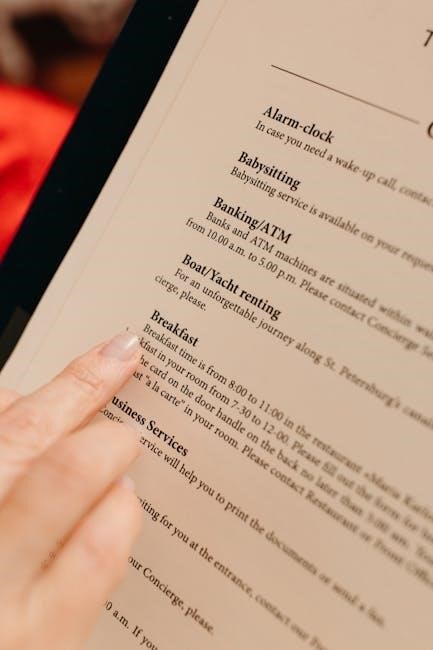Linking verbs connect the subject to a subject complement‚ describing or renaming it․ They don’t show action but rather a state of being or condition․
These verbs are essential for forming complete sentences‚ providing clarity and depth to descriptions․ Common examples include “be‚” “become‚” “seem‚” and others․
Some verbs‚ like “appear” or “feel‚” can act as both linking and action verbs‚ depending on context․ This duality adds complexity to their usage in sentences․
1․1 Definition of Linking Verbs
A linking verb connects the subject of a sentence to a subject complement‚ which describes or renames the subject․ These verbs do not express action but instead describe a state of being or condition․ Common examples include be‚ become‚ seem‚ feel‚ look‚ sound‚ and smell․ Unlike action verbs‚ linking verbs do not show activity but rather link the subject to an adjective‚ noun‚ or pronoun that provides more information about it; This unique role makes linking verbs essential for constructing clear and descriptive sentences in English grammar․
1․2 Importance of Linking Verbs in Sentence Structure
Linking verbs play a crucial role in sentence structure by connecting the subject to a subject complement‚ which provides essential information about the subject․ They help clarify the subject’s identity‚ condition‚ or state of being‚ making sentences more descriptive and meaningful․ Without linking verbs‚ sentences would lack the ability to express these details effectively․ For example‚ in “She is a teacher‚” the verb “is” links the subject to her profession‚ creating a complete and informative statement․ This function ensures sentences are balanced and convey the intended message clearly‚ making linking verbs indispensable in English grammar․

Common Linking Verbs
Common linking verbs include “be‚” “become‚” “seem‚” and “feel․” Some verbs‚ like “appear” and “grow‚” can function as both linking and action verbs depending on context․
2․1 The Verb “Be” and Its Forms
The verb “be” is the most common linking verb‚ with forms like is‚ are‚ was‚ were‚ am‚ and others․ It connects the subject to a subject complement‚ describing or renaming it without showing action․ For example‚ in “She is a teacher‚” “is” links the subject to the complement “teacher․” The verb “be” is essential for forming complete sentences and is often used in progressive tenses or as a helper verb․ However‚ in its linking form‚ it simply equates the subject to additional information‚ such as in “They were happy․” Its versatility makes it a cornerstone of English grammar․
2․2 Other Primary Linking Verbs (e․g․‚ Become‚ Seem‚ Feel)
Beyond “be‚” verbs like become‚ seem‚ feel are key linking verbs․ They connect subjects to complements‚ describing states or emotions․ For instance‚ “She feels happy” links “she” to “happy․” These verbs don’t show action but convey conditions or feelings‚ essential for nuanced sentences․ “He seems tired” and “They became famous” illustrate their linking role․ They add depth‚ providing detailed descriptions about the subject without indicating an action․ Their usage is vital for clear and expressive communication in English‚ offering a way to describe ongoing states or changes in condition effectively․
2․3 Verbs with Multiple Personalities (e․g․‚ Appear‚ Grow‚ Look)
Certain verbs‚ like appear‚ grow‚ look‚ can function as both linking and action verbs․ For example‚ “She looks tired” uses “look” as a linking verb‚ connecting “she” to “tired․” In contrast‚ “She looks at the map” uses “look” as an action verb․ Similarly‚ “He grows tomatoes” shows action‚ while “He grows tired” links “he” to “tired․” These verbs adapt based on context‚ making them versatile in sentence construction; Understanding their dual roles is crucial for accurate usage‚ as their function can change the sentence’s meaning entirely․ This flexibility adds complexity to their use in English grammar․

Examples of Linking Verbs in Sentences
Linking verbs like be‚ seem‚ feel connect subjects to complements․ For example‚ “She is happy” uses “is” to link “she” to “happy․” These verbs are essential for describing states․
3․1 Simple Sentences with Linking Verbs
Simple sentences using linking verbs clearly connect the subject to a complement․ For example‚ “He is tall” uses “is” to link “he” to “tall․” These sentences are straightforward‚ providing a direct description without additional complexity․ Linking verbs like be‚ seem‚ feel are commonly used․ Another example: “The cake smells delicious‚” where “smells” links “cake” to “delicious․” These sentences effectively convey information about the subject’s state or condition․
3․2 Complex Sentences Using Linking Verbs
In complex sentences‚ linking verbs connect subjects to complements‚ adding depth․ For example‚ “She appears exhausted after the marathon” uses “appears” to link “she” to “exhausted․” Similarly‚ “The flowers smell fragrant in the garden” connects “flowers” to “fragrant․” These verbs enhance sentences by describing states without indicating action‚ showcasing their versatility in complex structures․

Linking Verbs vs․ Action Verbs
Linking verbs describe a state of being‚ while action verbs show activity․ For example‚ “She is happy” uses a linking verb‚ whereas “She runs” uses an action verb․
Some verbs‚ like “appear” or “feel‚” can function as both‚ depending on context‚ adding versatility to sentence construction and meaning․
4․1 Key Differences
Linking verbs and action verbs serve distinct roles in sentences․ Linking verbs‚ such as be‚ become‚ and seem‚ connect the subject to a subject complement‚ describing or renaming it․ They do not express action but rather a state of being or condition․ Action verbs‚ on the other hand‚ describe physical or mental activities‚ such as run‚ think‚ or create․ Unlike linking verbs‚ action verbs can take direct objects and typically show what the subject is doing․ This fundamental distinction helps in understanding sentence structure and verb function․
Some verbs‚ like appear or feel‚ can function as both linking or action verbs depending on context․ This dual role adds complexity to their usage‚ making it important to identify their function in a sentence․ For example‚ in She feels the texture‚ feel is an action verb‚ but in She feels happy‚ it acts as a linking verb․ This distinction is crucial for proper grammar and clarity in writing and speaking․
4․2 Verbs That Can Function as Both
Certain verbs can act as both linking and action verbs‚ depending on their context․ For example‚ appear‚ feel‚ and look can function in both roles․ When used as linking verbs‚ they connect the subject to a subject complement‚ as in She appears happy․ However‚ when used as action verbs‚ they describe something being done‚ like The magician appeared on stage․ Similarly‚ feel can link the subject to an adjective (He feels tired) or describe an action (She feels the fabric)․ Understanding this dual role is essential for accurate sentence construction․

How to Identify Linking Verbs
Linking verbs connect the subject to a subject complement‚ often an adjective or noun․ They include forms of be (e․g․‚ am‚ is‚ are) and verbs like appear or feel․
To identify them‚ check if the verb describes a state or condition rather than an action․ For example‚ in She is happy‚ is links she to happy․
Some verbs‚ like look or seem‚ can function as both linking and action verbs․ Look for adjectives or nouns following the verb to confirm its role as a linking verb․
5․1 Understanding the Role of Linking Verbs
Linking verbs connect the subject to a subject complement‚ describing or renaming it․ They don’t express action but instead indicate a state of being or condition․ For example‚ in She is happy‚ is links she to the adjective happy․
These verbs often include forms of be (e․g․‚ am‚ is‚ are) and others like appear‚ seem‚ or feel․ Their role is to provide clarity and depth to sentences by linking the subject to additional information about it․
Understanding linking verbs is crucial for constructing grammatically correct sentences‚ as they help establish the relationship between the subject and its description or identity․
5․2 Exercises to Practice Identification
Practicing the identification of linking verbs is essential for mastering their usage․ Start by creating sentences using common linking verbs like be‚ become‚ and seem․
For example‚ identify the linking verb in sentences like:
– She feels tired after the workout․
– He appears nervous before the presentation․
– The cake smells delicious․
Use online quizzes or PDF worksheets to test your understanding․ Analyze whether the verb is linking or action-based by determining if it connects to a subject complement․
Additionally‚ rewrite sentences by replacing linking verbs with synonyms‚ ensuring the meaning remains intact․ This practice reinforces their role in sentence structure․

The Role of Linking Verbs in Grammar
Linking verbs connect the subject to a subject complement‚ such as an adjective or noun‚ essential for sentence completeness․ They establish the subject’s identity or condition․
6․1 Connecting Subject to Subject Complement
Linking verbs connect the subject to a subject complement‚ which can be a noun‚ pronoun‚ or adjective․ They essentially “link” the subject to additional information about it‚ enhancing the sentence’s meaning․ For example‚ in “She is a teacher‚” “is” links “she” to “a teacher‚” describing her identity․ This connection is vital for providing clarity and detail in sentences․ The subject complement completes the verb’s meaning‚ ensuring the sentence conveys a full thought․ Without linking verbs‚ such connections would be impossible‚ making sentences incomplete or unclear․ They play a crucial role in constructing grammatically correct and meaningful sentences․
6․2 Linking Verbs and Sentence Completeness
Linking verbs are essential for sentence completeness as they connect the subject to a subject complement‚ which provides additional information․ Without a linking verb‚ the sentence would lack clarity and completeness․ For example‚ “She *” (without “is”) leaves the sentence unfinished․ The linking verb ensures the subject is properly connected to the complement‚ creating a grammatically correct and meaningful sentence․ This connection is vital for conveying a complete thought‚ as the verb and complement work together to provide a full description of the subject․ Thus‚ linking verbs are indispensable for constructing clear and complete sentences․

Helping Verbs and Linking Verbs
Helping verbs‚ or auxiliaries‚ often combine with linking verbs to form tenses or aspects․ They enhance the main verb’s meaning‚ enabling complex sentence structures while maintaining grammatical correctness․
7․1 Auxiliary Verbs in Combination with Linking Verbs
Auxiliary verbs‚ such as “have‚” “has‚” and “had‚” often pair with linking verbs to express tense and aspect․ For instance‚ “She has been happy” uses “has” to indicate a current state․ This combination allows for nuanced expressions of time and duration in sentences․ Auxiliary verbs enhance the main linking verb‚ providing additional grammatical information․ Together‚ they form structures that convey complex meanings․ This partnership is essential for constructing grammatically complete and contextually rich sentences in English․ Auxiliary verbs thus complement linking verbs‚ ensuring clarity and precision in communication․ Their combined usage is fundamental to effective sentence formation․
7․2 Tense and Aspect in Linking Verb Constructions
Tense and aspect in linking verb constructions add depth to sentences by indicating when and how actions or states occur․ For example‚ “She was happy” (past tense) and “She has been happy” (present perfect) show different time perspectives․ Aspect modifies the verb’s timing‚ such as continuous or completed actions․ Linking verbs like “be” often combine with auxiliary verbs to form these structures․ Correctly using tense and aspect ensures clear communication of time and duration‚ making sentences more precise and meaningful․ This interplay is vital for conveying nuanced ideas in English grammar․ Proper usage enhances sentence clarity and effectiveness․

Common Mistakes with Linking Verbs
Confusing linking verbs with action verbs is a frequent error․ Misusing tenses and mixing aspects also occur‚ especially with “be” and its forms․ These mistakes can obscure meaning and confuse readers‚ making it essential to understand their proper roles in sentences to avoid such errors and ensure clarity in communication․ Proper identification and usage are key to effective writing‚ and attention to detail helps prevent these common pitfalls that can hinder clear expression of ideas․
8․1 Confusing Linking Verbs with Action Verbs
A common mistake is confusing linking verbs with action verbs․ Linking verbs‚ like “be” or “seem‚” connect the subject to a complement‚ while action verbs show activity․
For example‚ “She seems happy” uses “seem” as a linking verb‚ whereas “She runs” uses “runs” as an action verb․ Misidentifying them can lead to grammatical errors․
Some verbs‚ such as “appear” or “look‚” can function as both‚ depending on context․ Understanding their roles is crucial for correct sentence structure and clarity in writing․
Practicing identification and usage helps avoid this confusion‚ ensuring sentences convey the intended meaning effectively without mixing verb types․
8․2 Incorrect Usage in Tense Formation
Incorrect usage of linking verbs in tense formation is a common error․ For example‚ using “was” instead of “were” or misusing “been” can lead to grammatical mistakes․ Linking verbs like “be” have multiple forms‚ and using the wrong tense can confuse the sentence’s meaning․ For instance‚ “She been happy” is incorrect; it should be “She has been happy․” Such errors often occur when the verb form doesn’t match the subject or context․ Proper understanding of verb tenses and their correct application is essential to avoid these mistakes and ensure sentence clarity․

Resources for Learning Linking Verbs
Various resources like PDF lists‚ online exercises‚ and quizzes provide comprehensive guides to mastering linking verbs․ The “2200 Verbs List” and specific grammar worksheets are highly recommended․
9․1 PDF Lists of Linking Verbs
PDF lists of linking verbs are invaluable resources for learners‚ offering comprehensive guides to understanding and mastering these essential grammatical components․
Resources like the “2200 Verbs List” provide detailed collections of linking verbs‚ including “be‚” “become‚” and “seem‚” along with examples and exercises for practice․
These PDFs often include tips for identifying linking verbs‚ distinguishing them from action verbs‚ and using them correctly in sentences․
They are particularly useful for students and educators seeking structured materials to improve grammar skills and deepen understanding of English grammar fundamentals․

9․2 Online Exercises and Quizzes
Online exercises and quizzes are excellent tools for practicing linking verbs․ They provide interactive ways to test knowledge and improve grammar skills․
Many websites offer quizzes that focus on identifying linking verbs‚ understanding their usage‚ and distinguishing them from action verbs․
These resources often include tips for mastering linking verbs and feature exercises like fill-in-the-blank and multiple-choice questions․
Regular practice with these tools helps learners gain confidence and accuracy in using linking verbs effectively in sentences․
10․1 Summary of Key Points
Linking verbs are crucial for connecting subjects to subject complements‚ describing states of being‚ and enhancing sentence clarity․ Common examples include “be‚” “become‚” and “seem․” Some verbs‚ like “appear” and “feel‚” function as both linking and action verbs․ Proper identification and usage of linking verbs are vital for constructing grammatically correct sentences․ Resources such as the linking verbs list PDF offer comprehensive guides‚ including examples and exercises‚ to aid in mastering these verbs․ Regular practice with these tools can significantly improve grammar and sentence structure skills․
10․2 Final Tips for Mastering Linking Verbs
Mastering linking verbs requires consistent practice and a clear understanding of their role in sentence structure․ Start by memorizing the most common linking verbs‚ such as “be‚” “become‚” and “seem․” Practice identifying them in sentences and distinguishing them from action verbs․ Use resources like the linking verbs list PDF to reinforce your learning․ Pay attention to verbs with multiple personalities‚ as their function can change based on context․ Regularly review exercises and quizzes to solidify your understanding․ Finally‚ focus on applying linking verbs correctly in your writing and speaking to enhance clarity and grammar․